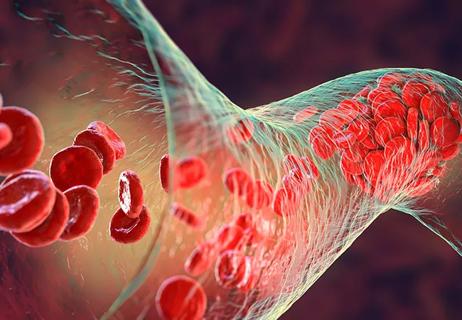Advertisement
Team collaborates to explore effects of genetic mutations to proteins OAS and RNase L

New research findings have revealed an underlying genetic cause for why some children who get infected with the coronavirus that causes COVID-19 develop multisystem inflammatory syndrome (MIS-C), a rare but potentially life-threatening disease.
Advertisement
Cleveland Clinic is a non-profit academic medical center. Advertising on our site helps support our mission. We do not endorse non-Cleveland Clinic products or services. Policy
The results, published in Science, are rooted in more than 40 years of research from Cleveland Clinic’s Robert Silverman, PhD, Cancer Biology. The study, led by Rockefeller University, found genetic mutations to the proteins OAS and RNase L dysregulate the inflammatory response in some immune cell types. That change enables excessive amounts of cytokines, which can cause inflammation in multiple organs, including the heart, lungs, kidneys and gastrointestinal tract. In the study, mutations were identified in a small subset of children with MIS-C.
OAS proteins are induced by interferons as a first line of defense against viruses. After sensing viral double-stranded RNA, OAS proteins make an activator of RNase L to degrade RNA in cells to prevent the virus from multiplying and spreading.
“RNase L acts like scissors to cut up messenger RNA that gets translated into proteins, including proteins known as cytokines that cause inflammation,” Dr. Silverman says. “The autosomal recessive mutations in MIS-C either prevent the scissors from operating (OAS mutations) or prevent the scissors from being made at all (RNase L mutations).”
The findings are the first potential genetic cause identified for MIS-C, a disease with broad symptoms like fever and vomiting that can lead to hospitalization. States have reported about 9,000 MIS-C cases, with 71 deaths, according to most recent Centers for Disease Control and Prevention numbers.
Addressing MIS-C is tricky because of all the unknowns associated with the disease including long-term effects, says Camille Sabella, MD, Director of the Center for Pediatric Infectious Diseases at Cleveland Clinic’s Children’s. There’s no definitive test for MIS-C, he says, so pediatricians need to rely on clinical criteria that can overlap similar infections and inflammatory conditions.
Advertisement
“Although we know how to prevent COVID-19 for the most part – even though it’s inevitable that everyone gets it at some point, it is not possible to prevent MIS-C because we don’t know the factors that cause it,” Dr. Sabella says. “Anything that we can do to figure out why some children get MIS-C and the majority of children do not is extremely important if we want to prevent it, or at least understand it.”
Dr. Silverman’s lab, which studies the role of interferons in immune responses with a focus on the OAS-RNase L pathway, collaborated with a team at Rockefeller University led by Jean-Laurent Casanova, MD, PhD. The investigators met virtually after Dr. Casanova spoke at Case Western Reserve University.
Dr. Casanova’s team found the mutations, in part, through analyzing DNA sequence data from MIS-C patients in comparison to other children who were infected with the coronavirus but did not contract MIS-C. One of the key research questions was whether increased virus multiplication or an exaggerated inflammatory response led to MIS-C in the cases with the mutations – the results indicated that it was an inflammatory response.
As part of an international collaboration, Dr. Silverman’s team determined what the specific effects of the mutations were on the pathway. That included screening dozens of mutant genes, identifying the effects on RNA and then correlating the results with the disease.
“Our team took what I had learned over the years about these enzymes to get the functional data that the study needed,” Dr. Silverman says. “Essentially, this validated the effects these mutations had on function.”
Dr. Silverman’s lab also contributed reagents not commercially available, synthesizing a small molecule that switches on RNase L and makes it cleave RNA.
The study determined that these mutations led to an exacerbated inflammatory response at a molecular level, according to the paper.
Knowledge about these mutations and how it affects immune mechanisms could provide more information on other diseases that cause chronic inflammation, like MIS-C’s counterpart in adults, and Kawasaki Disease, which presents similarly to MIS-C.
To prevent MIS-C, the CDC’s primary recommendation is to take preventive steps against COVID-19.
Support for this research came from the National Institute of Allergy and Infectious Diseases (NIAID) of the National Institutes of Health under award R01AI104887.
Editor’s note: This article originally appeared on the Cleveland Clinic Lerner Research Institute News website.
Advertisement
Advertisement

A review of IDSA and NIH guidelines

Results from the large, single-center, retrospective study have multiple implications for preventive care

Will enable patients with long COVID to enroll in national clinical trials

Evidence, clinical considerations, and why more research is still needed

As the pandemic evolves, rheumatologists must continue to be mindful of most vulnerable patients

Early results suggest positive outcomes from COVID-19 PrEP treatment

Elevated levels of vWF and FVIII associated with risk of blood clots, severe COVID-19 and death

Could the virus have caused the condition or triggered previously undiagnosed disease?